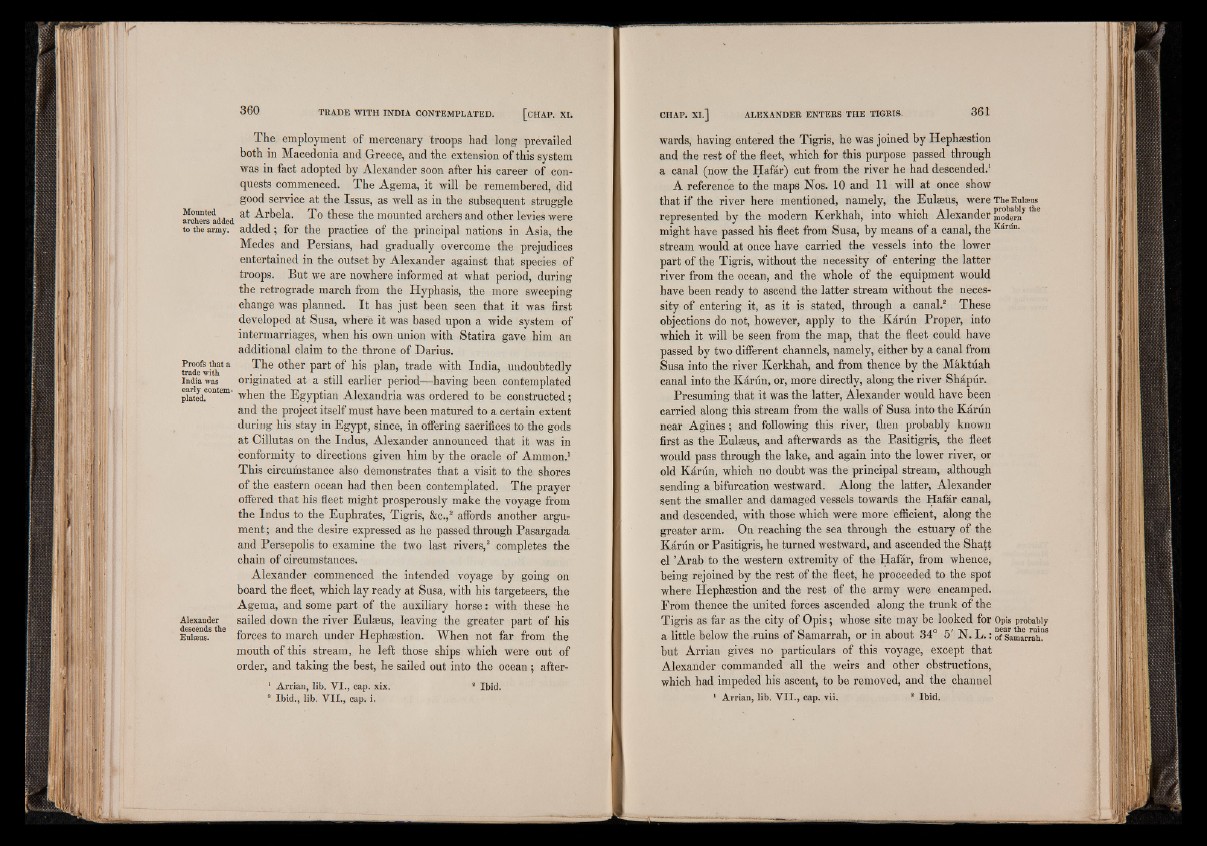
The employment of mercenary troops had long prevailed
both in Macedonia and Greece, and the extension of this system
was in fact adopted by Alexander soon after his career of conquests
commenced. The Agema, it will be remembered, did
good service at the Issus, as well as in the subsequent struggle
«¿here added ^rbela. To these the mounted archers and other levies were
to the army, added; for the practice of the principal nations in Asia, the
Medes and Persians, had gradually overcome the prejudices
entertained in the outset by Alexander against that species of
troops. But we are nowhere informed at what period, during
the retrograde march from the Hyphasis, the more sweeping
change was planned. It has just been seen that it was first
developed at Susa, where it was based upon a wide system of
intermarriages, when his own union with Statira gave him an
additional claim to the throne of Darius.
¡ ¡ ¡ ¡ § 1 3 The other part of his plan, trade with India, undoubtedly
India was originated at a still earlier period—having been contemplated
pSted.C°ntem' when the Egyptian Alexandria was ordered to be constructed;
and the project itself must have been matured to a certain extent
during his stay in Egypt, since, in offering sacrifices to the gods
at Cillutas on the Indus, Alexander announced that it was in
conformity to directions given him by the oracle of Ammon.1
This circumstance also demonstrates that a visit to the shores
of the eastern ocean had then been contemplated. The prayer
offered that his fleet might prosperously make the voyage from
the Indus to the Euphrates, Tigris, &c.,2 affords another argument;
and the desire expressed as he passed through Pasargada
and Persepolis to examine the two last rivers,3 completes the
chain of circumstances.
Alexander commenced the intended voyage by going on
board the fleet, which lay ready at Susa, with his targeteers, the
Agema, and some part of the auxiliary horse: with these he
Alexander sailed down the river Eulseus, leaving the greater part of his
Euiseus. forces to march under Hephaestion. When not far from the
mouth of this stream, he left those ships which were out of
order, and taking the best, he sailed out into the ocean; after-
1 Arrian, lib. V I., cap. xix. 8 Ibid.
8 Ibid., lib. V I I ., cap. i.
wards, having entered the Tigris, he was joined by Hephaestion
and the rest of the fleet, which for this purpose passed through
a canal (now the Hafar) cut from the river he had descended.1
A reference to the maps Nos. 10 and 11 will at once show
that if the river here mentioned, namely, the Eulaeus, were The Euteus
represented by the modern Kerkhah, into which Alexander modem5,
might have passed his fleet from Susa, by means of a canal, the Kiriin-
stream would at once have carried the vessels into the lower
part of the Tigris, without the necessity of entering the latter
river from the ocean, and the whole of the equipment would
have been ready to ascend the latter stream without the necessity
of entering it, as it is stated, through a canal.2 These
objections do not, however, apply to the Karun Proper, into
which it will be seen from the map, that the fleet could have
passed by two different channels, namely, either by a canal from
Susa into the river Kerkhah, and from thence by the Maktuah
canal into the Karun, or, more directly, along the river Shapur.
Presuming that it was the latter, Alexander would have been
carried along this stream from the walls of Susa into the Karun
near Agines; and following this river, then probably known
first as the Eulseus, and afterwards as the Easitigris, the fleet
would pass through the lake, and again into the lower river, or
old Karun, which no doubt was the principal stream, although
sending a bifurcation westward. Along the latter, Alexander
sent the smaller and damaged vessels towards the Hafar canal,
and descended, with those which were more efficient, along the
greater arm. On reaching the sea through the estuary of the
Karun or Pasitigris, he turned westward, and ascended the Shatt
el ’Arab to the western extremity of the Hafar, from whence,
being rejoined by the rest of the fleet, he proceeded to the spot
where Hephaestion and the rest of the army were encamped.
From thence the united forces ascended along the trunk of the
Tigris as far as the city of Opis; whose site may be looked for Opis probably
a little below the ruins of Samarrah, or in about 34° 5' N. L .: of Samarrah?5
but Arrian gives no particulars of this voyage, except that
Alexander commanded all the weirs and other obstructions,
which had impeded his ascent, to be removed, and the channel
1 Arrian, lib. V I I ., cap. vii. 8 Ibid.